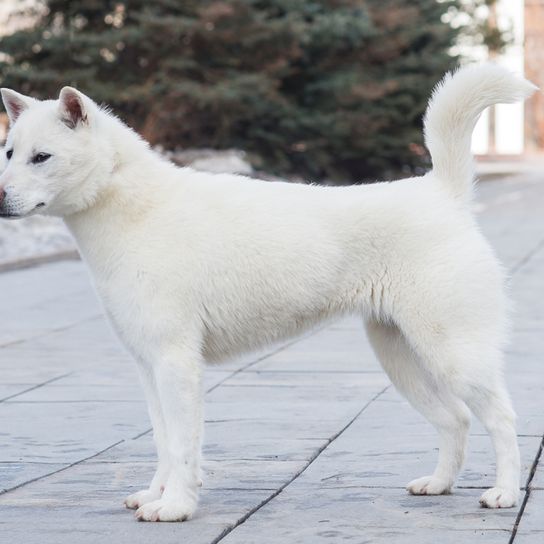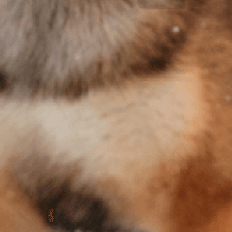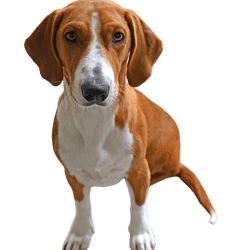
Kishu Breed description: Character & Co
Kishu
Facts & Origin
Kishu: origin and provenance
The Japanese Kishu is a hunting dog and is descended from medium-sized congeners from Wakayama and Mie prefectures, which formerly formed Kishū. The breed therefore gets its name from the area. Since the year 1934, only solid-colored dogs are allowed for breeding.
At the same time, in the same year, this breed was chosen as a monument of nature.
Does a Kishu Inu dog suit me?
If you ask yourself this question, then you have to consider a few things. Although the Kishu is a classic one-person dog, it is also very family-friendly and also, provided it is used to them, child-friendly. If you have a cat in the household and he doesn't know it, there is generally a risk that he will chase it, even to the point of it being fatal for the cat. Also, never leave the four-legged friend alone with small animals. Experience in dealing with dogs is essential here. The breed needs enough exercise, mental occupation and is not suitable for the city. The Kishu would be perfect for agility training, as it also needs to use its brain.
So before you get such a rare dog, please think carefully whether you can do justice to this breed.




| Alternate Name | Kishū-Inu, Kishu-Ken |
| Origin | Japan |
| Life expectancy | 10 - 13 years |
| Care requirements | low-maintenance |
| Activity level | high |
| FCI group | Asian Spitz and related breeds |
| AKC group | Foundation Stock Service |
| KC group | not recognised |
Attitude, character and temperament of the breed
Nature and character of the Kishu dogs
These four-legged friends are extremely person-oriented and therefore one-person dogs, so they build up an extreme bond to only one owner. However, this makes them extremely loyal.
However, you have to pay attention to their dominant appearance. This can lead to problems with other male dogs. Even in their own home, Kishus tend to pay attention to everything and want to dominate. They rarely show themselves submissive and only carry out orders if they see a sense in it themselves. Therefore, consistent training is indispensable for you.
This dog is very proud and it requires a lot of patience in the education.
Always make sure that you teach the dog leash control, because it will hardly be possible to let the Kishu run free.
Use
Characterized by a strong hunting instinct, this breed is characterized by its intelligence, courage and endurance. It is mainly used for hunting wild boar.
Character
Usage

Health and breeding information
Diseases of the breed
In general, the Kishus belong to an exceptionally healthy breed, but caution is advised with some congeners, as they are prone to hypothyroidism from time to time.
This inevitably leads to reduced function of the thyroid gland. Signs of this can be fatigue or reduced performance.
So if you own a Kishu Inu or want to get one, you must have these values checked by a vet. The course of the disease is not fatal, but it can be controlled quite well with tablets and the animals are consequently more balanced. Due to the shape of the eyes, the breed suffers from a genetic malposition of the eyelid, which could be corrected surgically. These quadrupeds can live up to 13 years.
Care
The common Kishu tends to be grain intolerant, so you should feed it primarily on meat. Food changes should take place slowly, always a little more. Again, a lot of patience is required.
The coat of the Kishu is easy to care for. Brush it once a week and more often during the coat change. Classically, the ears and claws should be kept under observation.


Breed characteristics and physique
The medium sized Kishus are muscular in stature and have a compact build with strong bones. They belong to number 318 of FCI group 5 and exist in red, white or sesame. Due to the pointed appearance, the Kishu carries his tail curled over his back. Equally distinctive are the pointed, erect ears. The height at the withers of females reaches about 46 cm and that of males 52 cm.
For this, the dogs gain a weight of up to 25 kilograms.
| Fur length | medium |
| Fur | - |
| Ear shape | Standing Ears |
| Tail | rolled up |
| Anatomy | rugged, sporty |
| Size ♀ | 43 - 49 cm |
| Weight ♀ | 13 - 27 kg |
| Size ♂ | 49 - 55 cm |
| Weight ♂ | 14 - 27 kg |
| Suitable For | - |
Colors




Known Diseases
Hypothyroidism
Most often, dogs get sick in middle age. Causes of hypothyroidism. Several causes of hypothyroidism are known.
Other medium dogs
Useful Articles
You can find articles that might interest you in the dogbible blog to match your favorite breed.
Visit our magazineto stay up to date on dog trends.
To find out more, view our Privacy Policy
Find here the breed that suits you and find out what character traits it has. Here you can also learn more about the origin, size and weight of your favorite breeds.
Matching your favorite breed, you'll find articles that might interest you on the dogbible dog blog.
Silver Labrador - buying, breeders and information
Hiking with dog in Saxon Switzerland
Dog ran away - what to do if the dog is gone?






















